There are times when a backpack becomes a trendsetter because it is on the forward edge of a fashion trend, creating a bump for an entire industry of companies chasing the idea of “the perfect pack”. They have cutting-edge styling and advertising campaigns that seem to push the boundaries of art.
Others meet at the intersection of a fitness craze and superb marketing techniques that hook the customer with an idea of quality and durability.
Then there are packs that are the sole survivor of gear purges because—as a veteran acquaintance said—they are like that favorite pair of jeans or broken-in jungle boots that you just can’t throw out.
Merrimack Webster defines the word icon as an emblem or symbol, and the Eagle Industries A-III assault pack has become an icon of the tactical gear Wild West of the late 1980s, when the military began to veer away from designing equipment in-house and started to procure load-carrying solutions tailored to fit a broad range of requirements. Most veterans who have owned an A-III will tell you without hesitation that it falls into the same category as their favorite pair of jeans and jungle boots.
During prior research on the history of the military pack, I uncovered bits and pieces of the story surrounding the A-III, but it was complicated by so much conjecture, third-hand knowledge and “I know a guy” commentary that I did not make mention of the A-III in the article. I knew it would have to wait for another day, when its full story could be told.
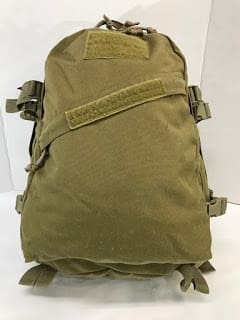
(Original version Eagle A-III. Photo by Steve S.)
I am a history junkie, so when I began the hunt for primary sources, it became difficult to discern the ground truth about a pack which was produced and sold in the hundreds of thousands over its lifetime. I’d come across chatter in tactical gear forums that the A-III was a knockoff of a Gregory design, so I’d spend time down that rabbit hole. Then I would hear whispers about the infancy of Eagle Industries and its relationship with the military, and drop into another rabbit hole for a while.
I caught my first break during a conversation with Kory Brown, product designer at Eagle Industries and owner of the tactical gear outfit Bergspitze Customs. He routinely interacts with some of the staff who were at Eagle when Carver was in charge.
He eventually walked out onto the sewing room floor one day in mid-2019 and spoke with one of the original seamstresses who had worked at the original 4,000 square foot facility in Webster Groves, MO. She told him that the first production model of the A-III was stitched up in November, 1989.
I had my first primary source!
Carver would eventually sell Eagle Industries to ATK/Vista after producing massive quantities of holsters, backpacks, rifle cases and assorted products for military and law enforcement customers during his stewardship of the company. It became the world leader in tactical gear and the industry standard for innovation, durability and functionality. He eventually moved on to other pursuits, opening a new company—Atlas 46—in Fenton, MO. This new venture produces tool storage, tool carriage, tool organization and personal workwear items, while also providing industrial design services. They even produce their own version of the A-III, the A3 Legacy, under the leadership of John’s son, Brian.
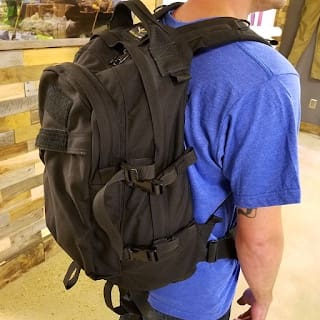
(Photo courtesy of Atlas 46)

(Photo courtesy of Atlas 46)
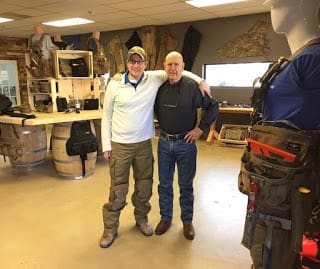
(Brian and John Carver – photo courtesy of Atlas 46)
The A-III was coming up on its 30th anniversary, but even armed with the date it was first stitched up, I wasn’t ready to write up a story about it. The online debates about the lineage of the A-III remained unresolved and this article missed the original publishing date, because I wanted to know the full story. A few knowledgeable folks in the industry had commented that the A-III actually evolved from a Lowe Alpine Systems design, but they could not remember what the original Lowe pack looked like, or how many modifications were made to make it meet military expectations. And there were still the folks who argued that it evolved from a Gregory pack.
The A-III is significant for being one of the first packs which were mass-produced for military customers without any design input from a military engineer, as was the process from years past. It is in fact a simple design, despite it sparking a revolution in load carriage across every branch of the military at the small unit level.
The key elements of the original are:
— A clamshell opening to the main compartment (approximately 16” x 20” x 7”) which allows it be opened about 3/4 of the way by dual zippers;
— A sturdy top carry handle;
— A 12” x 16” x 2” smaller front compartment which opens halfway down by its own dual zippers;
— Curved and padded shoulder straps;
— Side compression straps;
— Dual, covered openings on the sides of the carry handle which were sized to accommodate radio antennae (and eventually hydration bladder hoses)
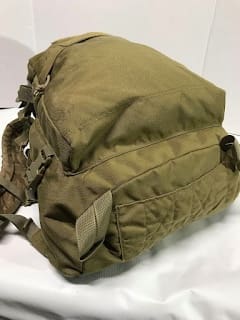
(Photo by Steve S.)
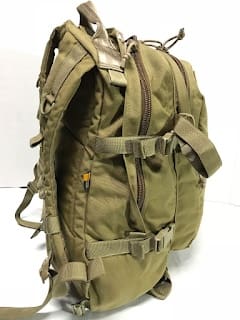
(Photo by Steve S.)
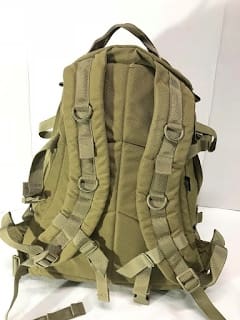
(Photo by Steve S.)
A slim, zippered slant pocket at the front measures 12” x 16” and is designed for quick access to maps, notebooks and writing instruments. A long strip of loop velcro runs along the upper edge of the pocket and can be covered with a velcro-backed nametape or luminous tabs. An accompanying square of loop velcro on the face of the pack and several inches above the slant pocket is sized for a flag or similarly-sized patch. The removable waist belt is not often seen on original examples of the pack, unless the user is trying to keep the pack original to full specifications or carries a lot of weight in it on a regular basis.
The back panel on an original is occupied by an elasticized pocket that can hold a frame sheet if the user requires a more rigid shape. It worked with varying degrees of success, depending on the role that the user employed the pack in.
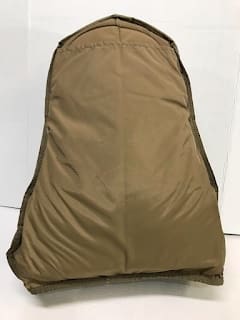
(Photo by Steve S.)
The original A-III was slick inside and out, but future iterations were produced with an internal webbing array to secure a long-range radio or similarly bulky item, along with side pockets and sections of webbing sewn to the outside to allow for canteens, binoculars, first aid kits, and ammunition to be attached by smaller pouches. More recent versions were updated with sections of Pouch Attachment Ladder System webbing, to accommodate Modular Lightweight Load-carrying Equipment pouches.
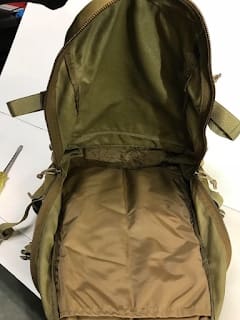
(Photo by Steve S.)
An oversized version was eventually developed with input from both Army and Marine Corps subject matter experts, resulting in an airborne version that could be rigged to a parachute harness. This capability required the design to meet a set of exacting safety certification standards, resulting in a pack that looks markedly different from the original version.

(Photo credit, Eagle Industries)
Kory Brown confirmed that the A-III is not currently available for retail sale at the Eagle website. However, SSD reported on a possible 3-day assault pack prototype at the Eagle booth during this year’s SHOT Show, so hopefully an updated version of the A-III will return to the retail sales lineup in the near future.
The A-III became a hit among the troops because it was available in subdued colors as well as the standard woodland pattern camouflage of the era. It had lashing points at the bottom and its side compression straps allowed for a wide range of accompanying gear to be attached, giving troops a capability to patrol with it for short-duration operations without dragging out a standard-issue pack. It also had a chest strap that was superior to anything on the issued packs of the day, making it at least marginally more comfortable when worn over body armor.

“The Hizara Province” by Elzie Goldman, illustrates use of A-IIIs in the opening years of Operation ENDURING FREEDOM in Afghanistan.
Even I owned an A-III, purchased from a postal exchange at Ft. Story when I was a junior member of the United States Marine Corps Fleet Antiterrorism (there is no hyphen) Security Team Company at Norfolk Naval Air Station in 1993. I eventually sold it some years later, either for beer or gas money and never acquired one again. The simplicity and clean lines of the pack stuck with me though and spurred me to learn the backstory behind this icon.
After almost a year of searching for contacts, nudging Mel Terkla (former lead designer at Kifaru and current owner of PocketUp) to make an introduction on my behalf to Carver, and multiple queries at the Atlas 46 website, I received an email out of the blue that Carver’s assistant would refer my queries to him at his Montana home. She forwarded my questions to John in the hopes that he could recall the A-III’s origins story, something created over 30 years ago.
I crossed my fingers and breathed a sigh of relief, even if ever so slightly.
I now had my second primary source, and what a goldmine of knowledge John Carver turned out to be! He sent me a document which laid out the history as best he could recall, and it filled in many of my gaps of knowledge about the A-III.
Over a series of emails, John laid out how the Eagle A-III came to life and I grew more excited that my search might be coming to an end. While he admitted that his memory has faded in patches, John distilled the information into a clear timeline, mentioning a few of the giants in the tactical gear world and the quiet professionals at the highest tier of American counterterrorism efforts who would use his packs.
John and his mother, Lorene Pyles, began operations in the basement of her St. Louis, Missouri home in 1974, where they produced nylon gear for motorcycle racing, including assorted bags, fanny packs, motocross pants, and a variety of other packs. By 1977, the company was building assault ladder covers for Arnold’s Welding Service (AWS) out of Fayetteville, NC for specialized Tier One military units and SWAT teams.
His memory gets a little less clear here, but as he recalls, Lowe Alpine Systems was a subcontractor to AWS for a pack which AWS in turn sold to satisfy equipment requirements for the 1st Special Forces Operational Detachment-Delta. I know there are going to be eye-rolls out there, but yes, THAT Delta. Because this branch of the Eagle story no longer influences his connections to military sales, I have no reason to doubt his statements.
As John recalled, Lowe had moved components of its manufacturing to Ireland and could not make their usual pack in the four or five colors that Delta required. They needed to be produced in black, olive drab, khaki and other subtle variants, so as to not resemble a full unit deployment when carried by the operators during parts of a mission. Lowe’s minimum order requirements were just too high for Delta to meet, because the unit only needed small batches.
Enter Bill Arnold at AWS, who contacted John about making modifications to the Lowe pack, in the colors which were required. John did that and the A-III was born. The first packs were made with an AWS logo on it, because Arnold didn’t want customers to take notice that he didn’t have the in-house sewing capability to fill the purchase order contracts. At John’s insistence, the classic Eagle logo eventually found its way onto the pack.

(Photo by Steve S.)
The Eagle A-III started showing up everywhere and Eric Graves (owner of SSD) recalls that in the early 1990s, the black A-IIIs were called “Ninja Bags” by the members of U.S. Joint Special Operations Command who were issued them. Other U.S. Army Special Forces veterans have recounted to me that their teams were outfitted with one or more of the bags per each team member. It eventually made its way into the general purpose forces, post exchanges and base clothing sales stores, ultimately becoming a pack that a slew of other manufacturers emulated, putting their own slant on the design with side pockets and cosmetic changes.
With each email I exchanged with John, I sensed his pride swelling when he mentioned his staff at the original Eagle facility. He was happy to retell the story of an amazing symbol of American entrepreneurship and dedication to customer service. He was remembering the heydays of a good company and good people.
Unfortunately, the discussion sent me back down another rabbit hole because I was left with the core question which I still felt compelled to answer: what inspired the A-III 30 years ago?
Claims by outside observers that Eagle had copied the Lowe pack still nagged at me, so I reached out to Lowe Alpine to see what someone there could say on the matter. I was assisted by an enthusiastic gentleman who informed me that Lowe had fallen on hard times through mismanagement at several points and was purchased by the company he now worked for as a customer service representative. Unfortunately, the last standing Lowe Alpine System employee had left two years prior to our discussion and he might not have even had knowledge of Lowe’s relationship with special operations units from that era.
I ended the email exchange with the Lowe rep feeling a bit defeated and frustrated. I had come so far, discussing the history of the A-III directly with the former owner of Eagle Industries, but was now left standing at the base of a very high wall.
I went back to John Carver with several photos of 1970s and 1980s Lowe designs, but none of them jogged his memory. The bag he had been asked to modify by Bill Arnold looked very much like the first A-IIIs which Eagle eventually produced. None of the product pictures we talked about came close enough.
On a cold and rainy April day in 2020, I used the collaborative capability of an internet chat tool to have a discussion with three giants in the tactical gear world: Darin Talbot of Extreme Gear Labs, Stephen Hilliard of Blue Force Gear and Eric Graves of SSD.
They knew that I had been on the hunt for the full story behind the A-III and each had contributed a breadcrumb here and there along my three-year path to enlightenment. They also knew my frustrations and had often witnessed the moment when I hit a dead end in a backpack forum, while trying to elicit details on the pack.
As we chatted, I described my communication with the Lowe rep and Eric began digging into his computer to produce some really old catalogs that are now hosted on vintage outdoor gear websites. He linked in the Lowe catalog from 1988 and flashed an example of a blue pack that was rectangular, but only had a few features similar to the A-III. We looked at it for a moment but decided it was too different to have inspired the Eagle version.
We had a nice chat and I decided to take a nap, feeling a bit tired from once again concentrating so hard on the Lowe angle of my search that seemed like just another dead end. Before I shut down my iPad, I went back to the link Eric had provided and started browsing, intrigued by just how many bright blue packs Lowe used to make back in the day.
I flipped a few pages, pinched the screen and zoomed, then flipped another few pages. There were a lot of boxy packs made in the late 1980s, worn by young backpackers wearing tube socks and really shiny nylon shorts.
I yawned, flipped another page and then froze. It couldn’t be. But there it was, on page 15. Offered in black and gray and coming in at 2,190 cubic inches and a weight of 2 lbs, 14 oz, the unmistakable teardrop shape and slant pocket of the “Adventure III” was staring back at me.
Lowe Adventure III…Eagle A-III. I felt a bit like Indiana Jones and went back to the chat to share my discovery. Everyone agreed that I had found the ancestor to the A-III, and the connection was now indisputable, settling all of the forum debates once and for all.

(Source:1988 Lowe Alpine catalog hosted at Larsonweb.com)
I emailed a picture off to John Carver immediately and he concurred that I had finally found it.
So what have I learned along the way during this three-year expedition into the history of a pack that became an icon, surviving for over 30 years and continuing to be held in the highest of regard by veterans who own one?
John Carver and his old Eagle team are another example of what I like to call “essential patriots”. They delivered a product that met the customer’s needs and became an example of American manufacturing along the way. Thousands of American warriors went to war with this pack slung over a shoulder, conducted combat missions and used it during their off-duty hours when they were safely back at home.
John closed one of our email conversations by adding a note that every modern soft goods manufacturer should follow:
“Listen to the customer, build what he asks for, build it to last and sell it at a fair price.”
The A-III lives on because an essential patriot listened to his customer.
I want to thank everyone who reads this article and knows that they assisted me along the way, even in what they may have thought was a minor aspect. It would not have been possible without your insight and patience.
Jon Custis is a veteran Marine infantryman who writes on a variety of tactical equipment, training, and leadership topics.


Thank you for this amazing piece of Gear History!
I have been wondering about the origins of the A-III for years and had plenty of discussions with fellow enthusiasts. Lowe Pro was as far as I managed to get (thx to SSD).
I think there are even photography backpacks in this design available.
In any case, I was not aware it goes back that far in time!
Again, thank you for that quality content!
This is some A+++ detective work and well written, excellent job Jon!
Out of curiosity, were AWS allowed/licensed by Lowe to produce the packs in the US, or was it simply a case of ripping off a design?
(and it’s interesting because there are so many claims that everyone copied the A-III, but if AWS/Eagle initially copied the design then that also settles all of those debates)
Absolutely LOVED reading this article!!! I’ve enjoyed using and buying Eagle Industries gear for quite a number of years – whereas some folks won’t leave home without their AMEX, I would not allow myself to be deployed without my CIRAS vest, my A-III pack or SERE/kangaroo pouch for that matter. Didn’t realize the two A-III’s packs I have(coyote & multicam) have such a range of provenance… Thank you, SSD!!
Got my pack about 15 years ago. Still going strong. Well made gear.
Wow – that is some hard corps dedication to the subject matter! Kudos and thank you!!
And once again proves that what Eric doesn’t know about gear, is probably not worth knowing. Amazeballs.
Great article and congratulations for the research on this iconic piece of gear!
Nice job hunting all of that down and then writing it up. Thank you!
I still have a mint OD Eagle AIII, not for sale. It’s a shame what’s happened to Eagle over the years
The first picture is a later version. Original AIII’s did not have the Velcro
I still have a mint OD Eagle AIII, not for sale.
The first picture in the article is not an original AIII, they did not have Velcro.
It’s a shame what happened to Eagle over the years.
Wow, this is amazing. Thank you for taking the time to do this for us all.
Always wanted to know the history of the ubiquitous assault pack I’ve carried and seen carried all over the world.
The Lowe connection is interesting. As soon as I saw that it started triggering memories, and its been nagging at the back of mind all morning that I’d seen that Adventure pack design even earlier than 1988 – like maybe from around 1984 or ’85. Was there an “Adventure I” and/or an “Adventure II” perhaps? If so, I haven’t found them yet.
I did however find a copy of Lowe’s catalog from 1981 that shows a smaller Day Pack with the same basic design as the later, bigger, Adventure Pack: http://www.outdoorinov8.com/pictures/image3821.jpg
And more interestingly, I found some info on Etsy about a vintage pack from the 1970’s, made by a company called Alpine Designs, that bears a certain resemblance to the later Lowe’s packs: https://i.etsystatic.com/6419512/r/il/56beba/460252445/il_794xN.460252445_q64d.jpg
Lowe Alpine has also released an “Adventure 20” pack as part of their Retro line, in celebration of the company’s 50th anniversary: http://www.oe-mag.co.uk/wp-content/uploads/2017/03/adventurer-twilight.jpg
Great story and research. I actually have one of the original blue and grey Lowe packs you found in that catalog. It was a gift a looong time ago. Out of the dozens of packs I’ve acquired over the years, I don’t even remember using it…think I took it climbing once or twice to carry rope and rack. It is one of the few “Non-tactical” packs i just kept in a gear bin and never gave away. I tried to give it to one of my kids to use at school, it’s in great shape and perfect size for a bunch of books and other stuff kids carry around, but it was apparently too old school.
Bravo, what a great read and trip down memory lane. I’d heard a few bits and pieces over the years but was curious, thanks for your time and efforts in producing this article, great read. Still have my original OD Eagle AIII and a black older version made by LBT before moving on to Kifaru, but both are still in great condition and get use.
I was a big fan of Lowe and owned one of their large packs in the late ’80s. I stopped paying attention and didn’t realize they had been sold a few times.
I found their current website, and they still sell a consumer pack that looks similar. Not nearly the size/ruggedness, but still “inspired” by the design, I suspect, and with a similar name.
https://lowealpine.com/us/everyday/heritage-backpacks/adventurer-20
Darin is a giant alright…
Thanks for the thorough and in depth article on the Eagle III-A! I learned a good bit. I had no idea it was – 30 year old design. I bought my black IIIA in 2005 and it’s still going strong.
My A-III still going strong after multiple deployments, now in use by my kid as his college backpack
That’s some dedicated research. Enlightening reading on a cool piece of tactical gear history. Thank you for your efforts Jon and SSD.
Wow, great article on a blast from the past! I still have 3 A-III’s (no Velcro) and all 3 are still going strong! Funny the comments I still get at Shot Show when I have one slung over my shoulder. Same reaction from Eagle’s original Drag Bags when I’m at the range.
Great vintage kit that ages like a fine wine! Thanks again for the great article, I miss the true qaulity nowadays and glad I purchased mutiple items back in the day!
Atlas 46 has a version of the AIII still.
Awesome!
What a phenomenal article, nicely done!
Out of curiosity, is the AWS of then the same AWS, Inc. of now also based in Fayettesville? Hearsay, but I read that AWS, Inc., was founded/managed by Tu Lam’s father (from Ronin Tactics)…unless his name is Bill Arnold! Would be interesting to see if there is any link there.
Same company
I loved this article, this should be a series. I’d read pretty much anything about gear history (Rhodesian rigs, mag shingles, CIRAS, etc)
I’m still rocking an original OD green gen 1 Lightfighter RAID I bought in 03, with an Eagle St Louis tag on it. Pretty neat since I live there now.
Still have a black version of the RAID pack, and still kicking myself in the noots for selling the OD I bought on LF when it first came out.
To me that’s still the best evolution to the III-A pack to ever happen. Stephen did an incredible job.
I still have a Mike Nowell’s garage built AIII I think I bought in ‘95 off post at Bragg. Carried it all over the world. I retired it after Iraq but there was nothing wrong with it. I just recently pressed it back into service for a special need. I kept those black and white Eagle catalogs I got in the mail after sending Eagle like $3.00 in 1992. Great story.
Sir, I have been looking for copies of those OLD Eagle catalogs for years. Any chance I could pay for some copies or scans?
Sir I have been looking everywhere for a pdf or copy of the OLD Eagle catalogs. Any chance I could send you a few bucks for a copy?
Great article. Like many younger soldiers I am more familiar with the Blackhawk! version of this pack being issued rather than the Eagle version. I hope I am not the only one that wants that 1980s blue version!
Thats some solid gear nerdery right there, thanks for making it happen!
Never knew the Delta linkage- but early 90’s the black AIII and Hi-Tecs were all the rage for a minute.
Awesome research that sheds light on something none of using them for the last three decades ever knew. I had different versions of AIII’s through out my career until the MR 3 Day became the new hotness. I just gave my OD Eagle AIII still in great shape to a coworker, but I still have my Large AIII and my first a Black Blackhawk variant I bought myself spray painted tan for a deployment in 94.
You did John and his legacy a credit with this article.
Woah, cease fire a minute here…nothing at all against either John Carver or Bill Arnold (both gentlemen I’ve met and respect), AND I do still have my 1989 vintage Eagle A-III (in a reduced scale Woodland pattern, and ordered from US Cavalry Store catalog), BUT…
The basic design certainly predates Eagle. I first saw this design in about 1986(?), and IIRC, was told by a prior-service 82nd fellow ROTC cadet that it was from a mysterious company called “London Bridge Trading”, which only super-high speed guys knew about. Pretty cool. Was years and years (pre-internet) before ever hearing “London Bridge” again.
Then maybe 4 years ago, somewhere, it might have been right here on SSD, or maybe on the old Kifaru Forum, there was discussion of all the various knock-offs of the A-III, and someone stated that it was never originally intended as an assault pack, or any kind of cool-guy gear. Supposedly it was first made by London Bridge, for WELDERS IN NAVY SHIPYARD to carry their welding masks, gloves, etc, to work. Then supposedly some SEALs saw it, and the idea spread. Supposedly.
That sounds interesting and I’d be interested in any research behind all of that. As stated above, the basic design pre-dates the A-III, because it was a Lowe Adventure III backpack.
If someone wants to go down the rabbit hole to find conclusive evidence of thIs LBT welder’s pack, rock on. That would be an interesting exercise.
Coolest piece of gear history I’ve read in ages. Still have all 3 of my original A-III’s, black, OD and Khaki. Actually sold my original OD I bought back in 95 and then got it back years later because I regretted selling it so much. Thanks for the history lesson.
I want to say thank you for all of the comments folks. It was definitely a history which needed to be written and preserved.
Nice research. I have the Lowe Adventure III one from the 80s in tactical Black, as well as one of the early Eagle ones i got in 1993 (obviously black too). I Traded an AWS one from a USAF guy (it as direct embroidery “TACP 3”), it’s definitively larger than the Eagle. Regarding the A3 history, there may be something taken from early lowe vector daysacks….and if you remember a brand named MEI, they produced a duffle bag with hidden shoulder straps and a zip off day pack which look like the A3, it’s more rectangular, but it has the unmistakable slanted zip map pocket. it was from the 70’s